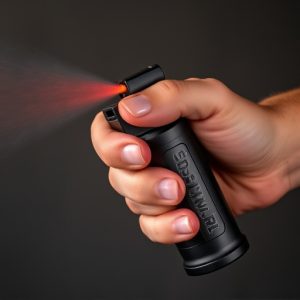Law Enforcement Pepper Spray Equipment: Safety, Science, & Removal Techniques
Pepper spray equipment is a critical tool for law enforcement, comprising canisters, holsters, trigg…….
Pepper spray equipment is a critical tool for law enforcement, comprising canisters, holsters, triggers, and safety features. Proper usage techniques, regular maintenance, and training are essential for effectiveness and reliability in high-stress situations. Removing pepper spray from clothing requires strategic methods due to capsaicin's water-repellent properties. Recommended steps include cold water rinsing, mild soap soaking, and specialized cleaning solutions or shampoos for stubborn stains. Officers must also follow best practices for storage, testing, and staying informed about local regulations to ensure community safety and legal compliance.
“In the dynamic realm of law enforcement, pepper spray equipment is an indispensable tool. Our comprehensive guide delves into the intricacies of this powerful device, from understanding its mechanisms to exploring the science behind its effects on clothing. We provide effective strategies for removing pepper spray from various fabrics, crucial safety and maintenance tips for officers, and practical advice for navigating post-incident care. Discover best practices to ensure the safety and efficacy of your pepper spray equipment.”
- Understanding Pepper Spray Equipment: A Comprehensive Overview
- The Science Behind Pepper Spray and Its Effects on Clothing
- Effective Strategies for Removing Pepper Spray from Various Fabrics
- Best Practices for Law Enforcement Officers: Safety and Maintenance Tips
Understanding Pepper Spray Equipment: A Comprehensive Overview
Pepper spray equipment is a critical tool for law enforcement, providing a non-lethal means of self-defense and crowd control. It works by irritating the eyes and respiratory system, temporarily disabling an individual. Understanding the different components of pepper spray gear is essential for officers’ safety and effectiveness in the field.
The primary component is the pepper spray canister, typically attached to a holster on an officer’s duty belt. These canisters contain a concentrated solution of capsaicin, the active ingredient derived from chili peppers. Officers must be trained in proper usage, including techniques for removing pepper spray from clothing, as accidental exposure can cause discomfort and impair visibility. Other equipment includes holsters, triggers, and safety features designed to prevent accidental discharge. Regular maintenance and training on these devices are vital to ensure their reliability during high-stress situations.
The Science Behind Pepper Spray and Its Effects on Clothing
Pepper spray, a powerful law enforcement tool, uses capsaicin, the active ingredient found in chili peppers, to disrupt sensory functions and cause temporary incapacitation. When deployed, the spray adheres to surfaces, including clothing, and can remain effective for extended periods due to its oily nature. This persistence poses challenges when it comes to removing pepper spray from clothing, as it requires specific methods tailored to different fabrics.
The process of eliminating pepper spray residue from garments involves careful steps. Water alone may not be sufficient, as capsaicin is water-repellent, causing the spray to spread and penetrate fibers. Specialized cleaning solutions designed for decontaminating clothing are recommended. These solutions break down the capsaicin molecules, rendering them harmless. For delicate fabrics, manual removal under running water might be suitable, but more robust materials may require soaking or using specialized brushes to agitate and dislodge the spray.
Effective Strategies for Removing Pepper Spray from Various Fabrics
Removing pepper spray from clothing can be a challenging task, but with the right strategies, it is possible to restore fabrics to their original state. The first step is to quickly rinse the affected area with cold water. This helps dilute the pepper spray and prevent it from setting into the fibers. Avoid using hot water as it can activate the spray further.
Once rinsed, soak the clothing in a mixture of mild soap and warm water for several minutes. This will help break down the pepper spray residue. Gently agitate the fabric to ensure thorough cleaning. After soaking, rinse again with cold water until all soap is removed. For tough stains, consider using a specialized pepper spray remover or a small amount of hair shampoo, massaging it into the stain before rinsing.
Best Practices for Law Enforcement Officers: Safety and Maintenance Tips
Law enforcement officers should adhere to best practices when it comes to pepper spray equipment to ensure safety and effectiveness. Regular maintenance is key; this includes checking the expiration date, inspecting for any damage or leakage, and ensuring the spray mechanism functions properly. Officers must also be trained in the correct usage, including learning how to remove pepper spray from their clothing and gear, as residual spray can affect visibility and cause discomfort or even health issues.
Additionally, proper storage is essential. Pepper spray should be kept in a secure, designated area, away from heat sources and direct sunlight, which can compromise its potency. Officers should also familiarize themselves with local regulations regarding pepper spray use and carry, ensuring compliance to avoid legal repercussions.
Pepper spray equipment is a vital tool in law enforcement, but it can also present challenges, particularly when it comes to decontaminating clothing. Understanding the science behind pepper spray and its interactions with fabrics is key to effective removal. By following best practices for safety and maintenance, officers can ensure their gear remains functional. Additionally, mastering strategies to remove pepper spray from various fabrics is essential for both officer safety and the preservation of evidence. With proper knowledge and techniques, law enforcement can navigate these situations efficiently.


